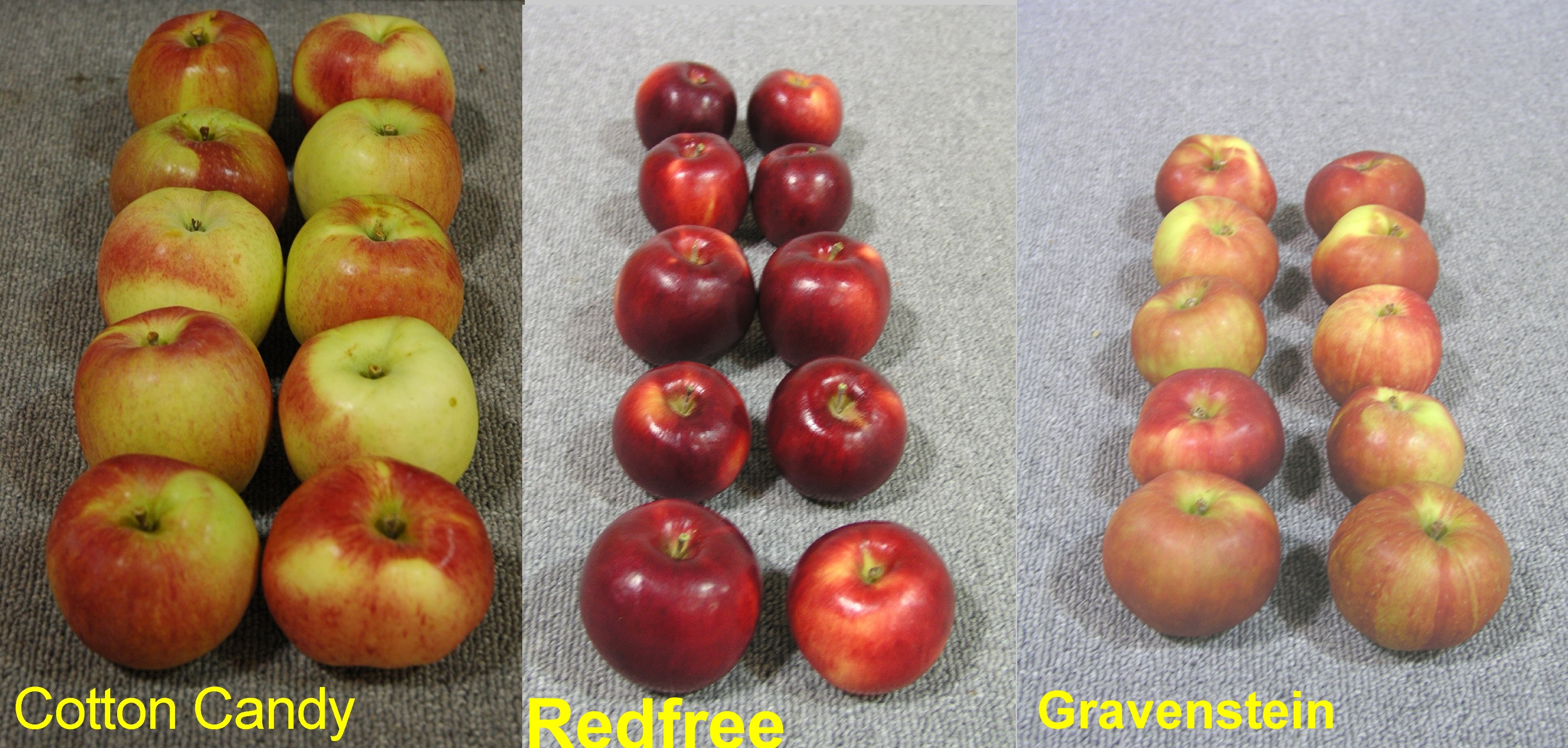Cotton Candy
| Denomination: | 'Cotton Candy' |
|---|---|
| Botanical Name: | Malus domestica |
| Applicant/Holder: |
Agriculture & Agri-Food Canada, Kentville Atlantic Food & Horticulture Research Centre 32 Main Street Kentville, Nova Scotia B4N 1J5 Canada |
| Breeder: |
David Crowe, Agriculture & Agri-Food Canada, Kentville, Nova Scotia Charles G. Embree, Agriculture & Agri-Food Canada, Kentville, Nova Scotia |
| Agent in Canada: |
Agriculture & Agri-Food Canada Office of Intellectual Property and Commercialization c/o Shannon Whyte 107 Science Place Saskatoon, Saskatchewan S7N 0X2 Canada Tel: (204) 999-9887 |
| Application Date: | 2001-10-04(priority claimed) |
| Application Number: | 01-2859 |
| Protective direction granted: | 2001-10-04 |
| Grant of Rights Date: | 2008-11-21 |
| Certificate Number: | 3394 |
| Grant of Rights Termination Date: | 2026-11-21 |
Variety Description
Varieties used for comparison: 'Redfree' and 'Gravenstein'
Summary: 'Cotton Candy' is an apple variety which has a drooping to weeping branching habit while trees of 'Redfree' are spreading and 'Gravenstein' has an upright habit. The branches of 'Cotton Candy' are at 90 degrees to the trunk while the branches of both reference varieties are at angles greater than 90 degrees. 'Cotton Candy' has some fruit bearing on the shoots and the spurs while both of the reference varieties bear fruit on the spurs only. 'Cotton Candy' has a medium number of lenticels on its one-year-old shoots whereas 'Redfree' has many and 'Gravenstein' has few. The leaves of 'Cotton Candy' are wider than both reference varieties. The length to width ratio of the leaf blades of 'Cotton Candy' is small whereas it is medium in 'Redfree' and large in 'Gravenstein'. The fruit of 'Cotton Candy' is very large while it is medium sized on 'Redfree' and large on 'Gravenstein'. 'Cotton Candy' fruit has a yellow ground colour, whereas 'Gravenstein' has a green yellow ground colour. 'Cotton Candy' has a moderate amount of streaked red overcolour while 'Redfree' has a very high amount of solid, dark red overcolour. 'Cotton Candy' has strong browning of the flesh, one hour after being cut, whereas it is weak in 'Redfree' and medium in 'Gravenstein'. 'Cotton Candy' fruit matures earlier than 'Redfree'.
Description:
TREE: medium vigour, drooping to weeping habit
BRANCHES: medium strength, 90 degree angle to trunk, fruit bearing on both spurs and shoots
ONE-YEAR OLD SHOOT: strong pubescence, strong shine on bark, medium number of lenticels
SHOOT TIP LEAF: green to white, concave to straight in cross section, moderate pubescence, mostly whitish over entire upper and lower side
LEAF: medium to large size, outwards facing orientation, small length/width ratio, serrate margin, moderate glossiness on upper side, pubescence present
STIPULE: large stipule
FLOWER: single type, mid season bud burst, mid-season beginning of flowering, dark pink bud in balloon stage, green and red pedicel
PETAL: touching to almost overlapping margins, light blue pink on upper side (RHS 56A), blue pink on lower side (RHS 62A)
FRUIT: very large diameter, globose, asymmetric in side view, medium ribbing, weak crowning at distal end, intermediate yield, early maturity, annual cropping
SEPAL: persistent calyx, medium length, free spacing at base, medium sized eye, aperture half opened
EYE BASIN: medium depth, broad
STALK: medium thickness, medium length
STALK CAVITY: mostly shallow, broad
FRUIT SKIN: smooth, bloom present, waxy, medium thickness, yellow ground colour, medium amount of streaked red over colour, absent or very low russet, small slightly prominent lenticels
FRUIT FLESH: white, absent or very weak core line, closed aperture of locules, moderate firmness, intermediate texture, medium juiciness, strong browning tendency
SEED: brown, normal shaped
DISEASE RESISTANCE: resistant to Scab (Venturia inaequalis)
Origin & Breeding History: 'Cotton Candy' originated from a cross conducted at the Agriculture and Agri-Food Canada Research Station in Kentville, Nova Scotia. The initial cross took place in the spring of 1991, between the parent varieties 'Redfree' and 'Oberle'. The resultant fruit produced from the cross were collected, their seeds dried, stored for about a month and then placed in a stratification media. Those seeds which germinated were grown and screened for susceptibility to apple scab. Resistant seedlings were kept and cared for in an extensive management approach. 'Cotton Candy' was identified in the field on August 23, 2001, by its sweet cotton candy-like flavour and its early maturation. The variety has been budded on Malling Merton 106 rootstock in the nursery at Agriculture and Agri-Food Canada Research Station, Kentville, Nova Scotia and will continue to be propagated by bud grafting.
Tests & Trials: Trials for 'Cotton Candy' were conducted at the Kentville Research Station of Agriculture and Agri-Food Canada in Kentville, Nova Scotia. Plots consisted of 5 to 6 five year old individually standing trees each of the candidate and reference varieties. 'Cotton Candy', 'Redfree' and 'Gravenstein' were planted on MM106 rootstalks.
Comparison tables for 'Cotton Candy' with reference varieties 'Redfree' and 'Gravenstein'
Shoot thickness of one-year-old shoot (mm)
| 'Cotton Candy' | 'Redfree' | 'Gravenstein' | |
|---|---|---|---|
| mean | 4.55 | 4.10 | 3.78 |
| std. deviation | 0.28 | 0.25 | 0.27 |
Leaf width (mm)
| 'Cotton Candy' | 'Redfree' | 'Gravenstein' | |
|---|---|---|---|
| mean | 78.81 | 60.04 | 63.82 |
| std. deviation | 6.33 | 6.79 | 2.54 |
Leaf length (mm)
| 'Cotton Candy' | 'Redfree' | 'Gravenstein' | |
|---|---|---|---|
| mean | 110.02 | 104.68 | 127.04 |
| std. deviation | 8.67 | 7.71 | 8.75 |
Fruit diameter (cm)
| 'Cotton Candy' | 'Redfree' | 'Gravenstein' | |
|---|---|---|---|
| mean | 9.02 | 7.08 | 7.72 |
| std. deviation | 0.51 | 0.37 | 0.35 |
Click on image for larger view

Apple: 'Cotton Candy' (left) with reference varieties 'Redfree' (center) and 'Gravenstein' (right)
- Date modified: